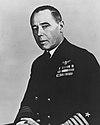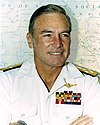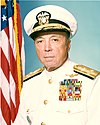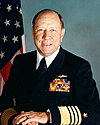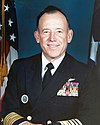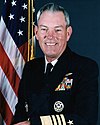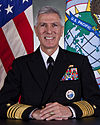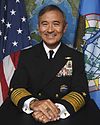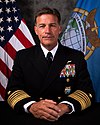
The United States Army Pacific (USARPAC) is an Army Service Component Command (ASCC) designated by the Secretary of the Army (SECARMY); it may also serve as a Joint Task Force headquarters. It is the army component unit of the United States Indo-Pacific Command, and its mission is to support the Commander, United States Indo-Pacific Command. The main areas that this command has jurisdiction in include Alaska, Hawaii, the Pacific Ocean, Japan, and South Korea. It also performs missions in Southeast Asia, in the countries stretching from the Philippines all the way to Bangladesh and India. United States Forces Korea (USFK) has had operational command and control of US Forces in Korea since January 2012, and USARPAC headquarters oversees the manning, training, and equipping of US Army forces assigned to USFK.

The United States Central Command is one of the eleven unified combatant commands of the U.S. Department of Defense. It was established in 1983, taking over the previous responsibilities of the Rapid Deployment Joint Task Force (RDJTF).

The United States Third Fleet is one of the numbered fleets in the United States Navy. Third Fleet's area of responsibility includes approximately fifty million square miles of the eastern and northern Pacific Ocean areas including the Bering Sea, Alaska, the Aleutian Islands, and a sector of the Arctic. Major oil and trade sea lines of communication within this area are critically important to the economic health of the United States and friendly nations throughout the Pacific Rim region.

Admiral Thomas Boulton Fargo served in the United States Navy during the late 20th century and early 21st century. He served as Commander, United States Pacific Command, at Camp H. M. Smith, Hawaii from May 2, 2002 to February 26, 2005. He was the twentieth officer to hold the position.

Pacific Ocean Areas was a major Allied military command in the Pacific Ocean theater of World War II. It was one of four major Allied commands during the Pacific War and one of three United States commands in the Asiatic-Pacific Theater. Admiral Chester W. Nimitz of the U.S. Navy, Commander in Chief, U.S. Pacific Fleet, headed the command throughout its existence.
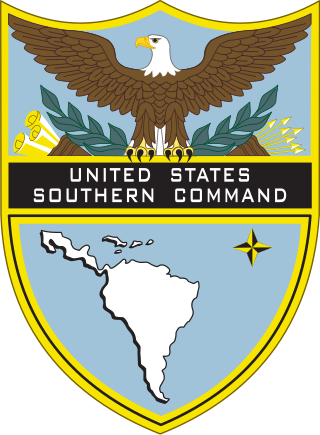
The United States Southern Command (USSOUTHCOM), located in Doral in Greater Miami, Florida, is one of the eleven unified combatant commands in the United States Department of Defense. It is responsible for providing contingency planning, operations, and security cooperation for Central and South America, the Caribbean, their territorial waters, and for the force protection of U.S. military resources at these locations. USSOUTHCOM is also responsible for ensuring the defense of the Panama Canal and the canal area.
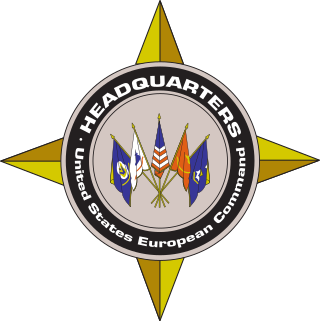
The United States European Command (EUCOM) is one of the eleven unified combatant commands of the United States military, headquartered in Stuttgart, Germany. Its area of focus covers 21,000,000 square miles (54,000,000 km2) and 51 countries and territories, including Europe, The Caucasus, Russia and Greenland. The Commander of the United States EUCOM simultaneously serves as the Supreme Allied Commander, Europe (SACEUR) within NATO, a military alliance. During the Gulf War and Operation Northern Watch, EUCOM controlled the forces flying from Incirlik Air Base.
A unified combatant command, also referred to as a combatant command (CCMD), is a joint military command of the United States Department of Defense that is composed of units from two or more service branches of the United States Armed Forces, and conducts broad and continuing missions. There are currently 11 unified combatant commands, and each is established as the highest echelon of military commands, in order to provide effective command and control of all U.S. military forces, regardless of branch of service, during peace or during war time. Unified combatant commands are organized either on a geographical basis or on a functional basis, e.g., special operations, force projection, transport, and cybersecurity. Currently, seven combatant commands are designated as geographical, and four are designated as functional. Unified combatant commands are "joint" commands and have specific badges denoting their affiliation.

Harry Binkley Harris Jr. is a retired Japanese-born American diplomat and retired U.S. Navy officer. He was the first American of Japanese descent to lead US Pacific Command and was the highest-ranking American of Japanese descent in U.S. Navy history during his time as commander.

The Alaskan Command (ALCOM) is a joint subordinate unified command of the United States Northern Command, responsible for operations in and around the State of Alaska. Alaskan Command is charged with maintaining air sovereignty, deploying forces for worldwide contingencies as directed by the Commander, US Northern Command, providing support to federal and state authorities during civil emergencies and conducting joint training for the rapid deployment of combat forces. ALCOM combined forces include more than 16,000 Air Force, Army, Navy and Coast Guard personnel, and 3,700 guardsmen and reservists. Recently, the Command Representative for Missile Defense position was created to be the focal point for all issues related to Ground-Based Midcourse Defense in Alaska, in support of Alaskan Command, the Alaska NORAD Region, and the Eleventh Air Force.

The U.S. Marine Corps Forces, Pacific (MARFORPAC) is the Marine Corps service component command of U.S. Indo-Pacific Command. It is the largest field command in the Marine Corps and is headquartered at Camp H. M. Smith in Hawaii. The MARFORPAC area of responsibility covers more than half of the Earth's surface.
Sea Frontiers were several, now disestablished, commands of the United States Navy as areas of defense against enemy vessels, especially submarines, along the U.S. coasts. They existed from 1 July 1941 until in some cases the 1970s. Sea Frontiers generally started at the shore of the United States and extended outwards into the sea for a nominal distance of two hundred miles.

The ANZAC Area, also called the ANZAC Command, was a short-lived naval military command for Allied forces defending the northeast approaches to Australia including the Fiji Islands, New Hebrides, and New Caledonia during the early stages of the Pacific Campaign of World War II. The command was created on 27 January 1942. United States Navy Vice Admiral Herbert Fairfax Leary commanded the force. The force co-existed with the Allied ABDA command which was charged with defending Allied colonial territories in Southeast Asia and the Southwest Pacific from Imperial Japanese aggression.
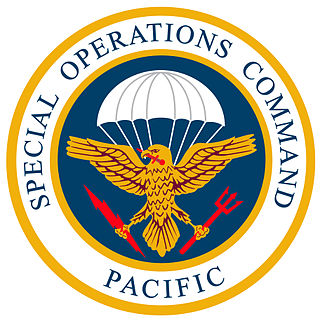
The Special Operations Command Pacific, known as SOCPAC, is a sub-unified command of the United States Department of Defense for special operations forces in the United States Indo-Pacific Command (USINDOPACOM) area of responsibility.
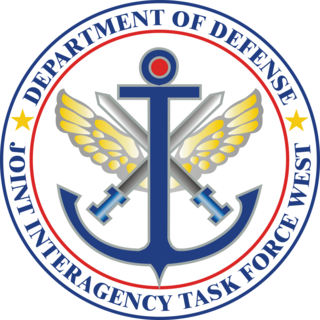
Joint Interagency Task Force West is a standing United States military joint task force with the mission of combating drug-related transnational organized crime in the Indo-Asia-Pacific. JIATF West's area of responsibility (AOR) is that of United States Indo-Pacific Command (USINDOPACOM). JIATF West is one of two Joint Interagency Task Forces with a counter-narcotics mission. The other is Joint Interagency Task Force South. The task force is run as USINDOPACOM's "executive agent" for counterdrug activities providing support to partner nation law enforcement. Approximately 100 active duty and reserve U.S. military forces; Department of Defense civilian employees; contractors; and U.S. and foreign law enforcement agency personnel are members of the task force.
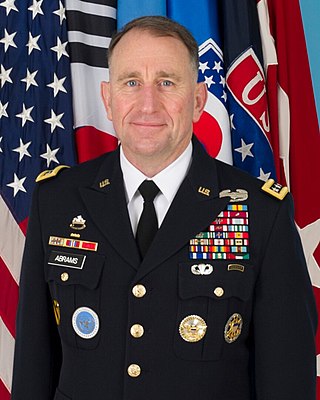
Robert Bruce Abrams is a retired four-star general in the United States Army who last served as the commander of United States Forces Korea. He concurrently served as the commander of United Nations Command and commander of R.O.K.-U.S. Combined Forces Command. He previously served as the 22nd commanding general of United States Army Forces Command from August 10, 2015 to October 17, 2018. He was a 1982 graduate of the United States Military Academy where he was commissioned as an armor officer. During his years of active service, he has held command and staff positions across the Army and joint community in Germany, the United States, Southwest Asia and South Korea. Abrams comes from a family of career military officers. His father was former Army Chief of Staff General Creighton W. Abrams Jr., and both of his elder brothers, Creighton and John, were Army general officers.

Far East Command (FECOM) was a unified combatant command of the United States Department of Defense, active from 1947 until 1957, functionally organised to undertake the occupation of Japan and Korea. The 1st and 6th Marine Divisions, who from 1945 to 1948 assisted the Chinese government in occupying northern China, disarming the Japanese, and helping the Kuomintang Chinese without fully getting involved in the Chinese Civil War, were not part of Far East Command and reported to Pacific Command and the U.S. Navy.
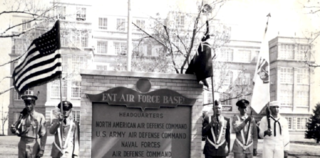
Continental Air Defense Command (CONAD) was a Unified Combatant Command of the United States Department of Defense, tasked with air defense for the Continental United States. It comprised Army, Air Force, and Navy components. It included Army Project Nike missiles anti-aircraft defenses and USAF interceptors. The primary purpose of continental air defense during the CONAD period was to provide sufficient attack warning of a Soviet bomber air raid to ensure Strategic Air Command could launch a counterattack without being destroyed. CONAD controlled nuclear air defense weapons such as the 10 kiloton W-40 nuclear warhead on the CIM-10B BOMARC. The command was disestablished in 1975, and Aerospace Defense Command became the major U.S. component of North American Air Defense Command (NORAD).

403d Army Field Support Brigade (AFSB), headquartered at Camp Henry, Daegu, Republic of Korea, delivers U.S. Army Materiel Enterprise to supported forces throughout the Korean and Japanese Theaters of Operations.

The K. Mark TakaiPacific Warfighting Center is located on Ford Island in Honolulu, Hawaii within the Ford Island Historic Management Zone / Aviation Facilities Sub-Area, part of the Pearl Harbor National Historic Landmark. This building, formerly called The Pacific Warfighting Center (PWC), is primarily used to direct forces during disaster relief efforts as needed within the United States Indo-Pacific Command (USINDOPACOM).




















